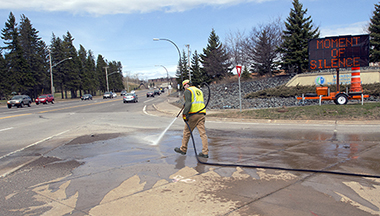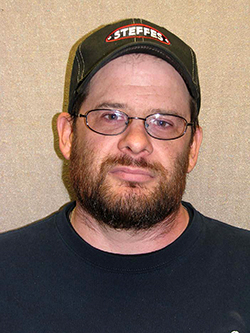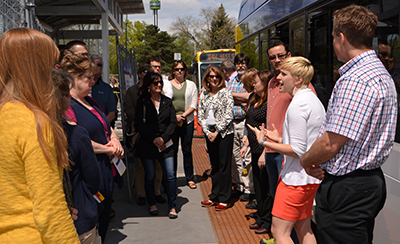 |
|

|
 |
TABLE of CONTENTS
 |
Workers Memorial Day events honor fallen workers |
By Mary McFarland Brooks

Traffic rushes by Jason McPherson, District 1 transportation associate, as he power-washes a section of raised concrete median outside the district headquarters in Duluth April 28. The changeable message sign behind him was programmed with Workers Memorial Day messages. Photo by Beth Petrowske |
MnDOT’s districts 1, 6 and 7, Metro District and Central Office marked Workers Memorial Day April 28, which commemorates the fallen workers who died while working on MnDOT construction and maintenance projects.
“The passing of these workers is a tragic reminder of the dangers men and women face while keeping Minnesota’s roads safe for the driving public. No one has to give their life to make a living,” said Commissioner Charlie Zelle. “It is important that motorists honor all the workers who lost their lives on-the-job by using extra caution in work zones.”
Since 1960, 34 MnDOT employees and 15 private sector contractors have died on the job while working on Minnesota highways.
District 1 observed the day by flashing safety messages on changeable message signs throughout the district. Duane Hill, District 1 engineer, sent a message to encourage employees “…to make our work zones and our work safer through training, daily vigilance and teamwork.” Employees remembered the transportation workers who were killed or injured on the job by observing a moment of silence.

Todd Stevens, District 6 assistant district engineer for east operations, speaks at the District 6 Workers Memorial Day program in Rochester April 28. Photo by Mike Dougherty |
Each year, District 6 joins with the Southeast Minnesota Area Labor Council to remember the district's six workers who died on the job since 1964 and remind motorists of the importance of safety in work zones. Approximately 230 MnDOT, Olmsted County and city of Rochester workers attended the event on April 28. The audience heard from Chief of Staff Eric Davis, State Patrol Lt. Heath Dienger and Chuck Ackman from Sen. Amy Klobuchar’s staff.
Ken DeCramer, the District 6 materials lab supervisor, told the audience how he was injured four weeks into his MnDOT career in 1989 when an impatient driver swerved around a flagger in Red Wing and struck DeCramer while he was on a survey crew. DeCramer described himself as lucky to be able to eventually return to work after the crash.
Rochester Mayor Ardell Brede read a proclamation for Workers Memorial Day in Rochester. Todd Stevens, assistant district engineer for District 6 operations, emceed the program and read the names of each of the District 6 workers who died while working on-the-job.
In District 7, Workers Memorial Day is observed annually with AFSCME Local 280. The State Patrol presented, as did District Engineer Greg Ous. Union officials read the poem These Chairs by previous safety administrator Dale Plemmons. District 7 honored two people who had lost their lives on-the-job: Mike Struck and Darrell Blackwell. Several family members of the fallen workers attended the event.
The Metro District provided a day-long silent memorial to fallen workers with chairs, vests and hardhats throughout the building.
Central Office honored all fallen workers across the state with posters, chairs, vests and hardhats placed by the elevators.
Visit www.mndot.gov/workermemorial/ to read Gov. Mark Dayton’s Workers Memorial Day proclamation and to learn more about the permanent worker memorial located at MnDOT’s Central Office in St. Paul. |
 |
|

|
 |
TABLE of CONTENTS
 |
District 4 employee eligible for vacation donation |

Charles Larson, transportation generalist in District 4, has been approved for the Vacation Donation program.
Photo courtesy of District 4
|
Charles Larson, transportation generalist in District 4, was hospitalized with a life threatening illness in February. Larson has worked for MnDOT since 2002.
Due to his illness, Larson has exhausted all of his vacation and sick leave and has been approved for the Vacation Donation program. Employees may donate up to 40 hours of vacation per fiscal year for approved recipients who have exhausted their sick and vacation leave due to injury or illness.
Joe Sass, who was highlighted in the last issue of Newsline, is also eligible for the program.
To donate vacation hours, go to the Employee Self Service Web site and click “Other Payroll” and then “Leave Donations.” The site also allows employees to view a list of all state employees eligible for the program and enroll as a recipient.
A paper form is also available online to donate to an employee on the Vacation Donation Program. |
 |
|

|
 |
TABLE of CONTENTS
 |
Employees encouraged to reduce data storage during clean-up week |
By Jennifer W. Witt, records and information manager

May 23 – 27 is data clean-up week for MnDOT employees. |
MnDOT is focusing on giving employees the time and help needed to use the retention schedule to dispose of unnecessary electronic files. In the ongoing efforts to reduce electronic data storage and follow the records retention schedule, MnDOT will have a clean-up week. It is going to be a competition to see who can reduce their electronic storage by the most percentage points. The winner will get the MnDOT Golden Hard Drive.
All district engineers and office managers will schedule four hours for their respective groups to review all electronic files between Monday, May 23, and Friday, May 27.
"It's important to be good stewards of all of our assets, which includes both paper and electronic data,” said Tracy Hatch, deputy commissioner, chief financial officer and chief operating officer. “MnDOT spends significant resources each year storing and retrieving information. This also poses a significant legal liability on our part. I encourage all employees to be sure they are complying with our records retention policy and practices, and then to the extent allowable, clean up electronic and paper records to minimize the storage and potential legal costs. It just makes good business sense."
During this time, all employees will:
- Review their electronic documents to determine if they are records or not.
- Delete all outdated non-records.
- Review all records and delete or dispose of records that have reached its retention period. How long to keep each type of record is on the Retention Schedule.
- As always, make sure there are no non business-related personal files and data on MnDOT’s network drives. This includes shared and individual drives.
- Time spent doing clean-up activities can be put under source type 0023 in your timesheet.
Fill out a records destruction report for all records that are deleted. State law requires all agencies to permanently retain a list of destroyed records. Use this form to document destruction of records that are listed on the MnDOT retention schedule. Reports are not needed for non-record material. Copies, drafts and meeting agendas are not records and can be disposed of at any time.
Storage levels will be posted on the Records Management webpage. The reduction will be measured by percentage, so that larger districts or offices do not have an unfair advantage. The district or office with highest percentage in decrease to their digital storage footprint will be announced June 2.
The web is not considered a long-term storage site. Employees should look at items stored on the web and anything that needs to be kept long-term should be put in eDocs, ProjectWise or some other long-term structured environment. See the MnDOT Website Development and Management policy. |
 |
|

|
 |
TABLE of CONTENTS
 |
MnDOT planners, designers tour new A Line route |
By Sue Roe

Katie Roth, project manager of the Metro Transit A Line, talks to MnDOT employees about the state’s first urban bus rapid transit service during a tour last week. MnDOT employees in the planning, design and traffic offices worked with the Met Council to design the line. Photo by Sue Roe |
MnDOT planners and designers who worked on the state’s first urban bus rapid transit service got a first-hand look at the route on Snelling Avenue last week in St. Paul. The Metro Transit A Line combines features of light rail transit with the flexibility of bus travel. The new service begins June 11.
The Metropolitan Council, which oversees Twin Cities transit, offered the tour on one of the 12 new buses that will run the route.
MnDOTwas involved throughout the different phases of the project, which began in 2011. The agency reviewed Met Council’s design plans for the 20 stations, coordinated and did mill and overlay work at eight locations and conducted studies to verify traffic impacts.
The new service will operate on one of the Twin Cities’ busiest corridors. The route runs from Rosedale Center in Roseville to the 46th Street light rail station in Minneapolis, following Snelling Avenue and Ford Parkway in St. Paul. The route connects to two of the Twin Cities’ light rail lines.
MnDOT contributed $6 million of trunk highway bonds to the $27 million project. The Legislature approved $10 million from the general fund budget; Federal Congestion Mitigation Air Quality funds and the Met Council shared the remaining costs.
The A Line is being touted as “a new kind of bus, a new kind of fast” by offering easier boarding, sidewalk pay stations and fewer stops. Buses will run every 10 minutes during rush hours, midday, evenings and weekends. The buses use “transit signal priority” to interact with traffic signals to turn lights green earlier or extend green lights longer.
Features of the bus include low floors for easy boarding, ramps to assist those with mobility needs, extra-wide doors and aisles and push buttons and bars, instead of pull cords. All these features are designed to help passengers get on and off quickly. The buses also have free Wi Fi.
The stations along the route are located after stop lights instead of before to reduce travel time. The stations include customer waiting shelters, pylon markers with real-time transit information displays and ticket vending machines. Users pay fares at the station, instead of on the bus, another time saver.
The stations also have security cameras, benches, emergency telephones and bike racks.
“The potential impact will be that people can move quicker in the corridor,” said Carl Jensen, Transit Advantages engineer in the Metro District. “Hopefully this means people will start taking other means of transportation than their cars to travel in the Twin Cities.”
The project started development in 2011 and 2012 with public open houses, corridor planning and a feasibility study. More public meetings followed in 2012 and 2013, and the final plan was approved in 2014. Construction began in 2015.
For more information on the A Line, go to http://www.metrotransit.org/a-line-project-faqs.
|
 |
|

|
|

|
 |
TABLE of CONTENTS
 |
Work zone crash forever etched in employee’s memory |
|
By Jennifer Hills, District 8 Marshall construction office manager

Jennifer Hills, District 8 Marshall construction office manager, talks knows first-hand the dangers of work zones. Photo courtesy of District 8 |
Work zone safety - what does it mean to you? Events unfold everyday in our lives and sometimes our actions lead to unfortunate consequences. I would like to share my work zone story that affected my life and how I think of safety. This story is not the worst of my experiences, but it’s the one I can talk about.
For me, work zone safety is everything around me, especially while I am driving my car, going for a walk, plowing snow or riding my bike. My utmost attention is needed to ensure I go home to my family every day. I drove school bus for a time and was on an ambulance crew for 10 years. Safety and awareness were the keys to success. I use the word success because there was never a crash, or even a close call. I had what I like to call, a controlled scene.
I work for MnDOT in the District 8 Marshall office. I’ve worked for this amazing agency for 10 years and truly enjoy what I do. I started out as a part-time snowplow operator and eventually became full-time in maintenance and then transferred to construction and then as office manager in the Marshall office. I am also a plow operator out of the Pipestone Truck Station.
During my four years in construction I worked on nine projects, and I am sad to say, it was not crash-free.
The 2014 construction season was the year of the work zone crash. The location was Hwy 59 on the north side of Garvin Hills on a beautiful spring afternoon. All work zone signs were in place, the flaggers had their required safety gear on and they were stopping traffic heading south due to a temporary lane closure. A small pick-up stopped for one flagger as she directed him to do so. Moments later there was a loud crash. A commercial vehicle slammed into the back of the pick-up, lunging it forward directly into the path of the flagger. Both vehicles had only one occupant. The flagger was within inches of being seriously injured, or worse yet, killed.
My EMT training and experience immediately took over the scene until fire and rescue arrived. Instantly I had three victims to look after and a construction project to continue to oversee. Phone calls to 911 and my engineer were the first to go out. Next was to shut the project down as the distractions on the roadway could create the possibility of additional crashes. Quickly I had to determine which victim to look after first. The scene was chaotic.
The flagger and driver of the commercial vehicle were both walking so I asked them to sit down. The driver of the pickup was walking but with apparent injury and in shock. His injuries extended to his head, face, arms and back. He was scared and hurting, which made it difficult to find out pertinent information and to protect his cervical vertebrae.
Moments later, fire and rescue arrived and assumed responsibility for all three victims. I had to turn my EMT brain off and turn my inspector brain back on.
My engineer and I re-addressed all signs within the work zone to check for compliance and the contractor had followed our guidelines and specs that had been put in place. The cause of the crash was that the person driving the commercial vehicle was not paying attention as he drove through our work zone.
So many things ran through my head and I felt responsible for the terrible, traumatizing events that had just happened. When my engineer arrived he helped me with the overwhelming guilt that this was my fault. That moment was emotionally difficult and I had to focus my responsibility to the project and to get the road back open.
No one died but everyone lost something that day all because someone didn’t pay attention to their surroundings. I often think of that event and how one person’s actions led to those unfortunate consequences.
At the beginning, throughout and the end of each day, we all have a responsibility to ensure our own controlled scene. (Remember, I mentioned that in the beginning of the story). Please don’t drive distracted. I want you to go home to your loved ones today, and every day. |
 |
|
| |
|



